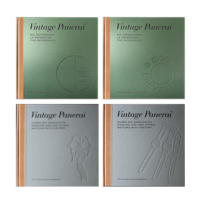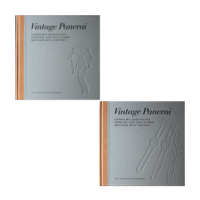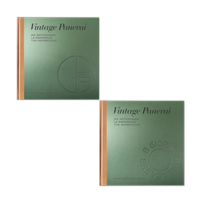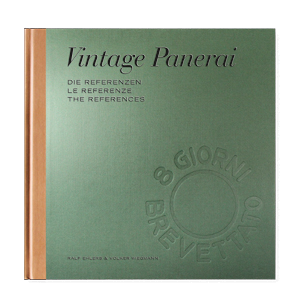Tag: “History2”
Spot on: chapter V of “History2”
by Volker on Jul.25, 2014, under Allgemein
 CHAPTER V – “Jochen Burnus”
CHAPTER V – “Jochen Burnus”
(112 pages, 67 photos, 4 technical illustrations)
The chapter on Jochen Burnus describes his period of duty as a combat swimmer, from his posting away from Yugoslavia in 1944 and his training in northern Italy to his missions at the Elbe, where he ended up in American captivity on April 20th, 1945. After his release he worked in Hamburg Harbour as a recovery diver, together with other former combat swimmers, including Siegfried Köneke, who also belonged to the “Einsatzgruppe Keller” in the Second World War. Burnus later received his friend’s Panerai watch (Ref. 3646 / Type D) from Köneke’s parents, after Sigi was killed at the age of 28 in tragic circumstances while working in Hamburg Harbour on March 14th, 1949. Thus the stories of two combat swimmers merge inseparably and allow us to trace the journey of a combat swimmer watch and its earlier owners from 1944 to the present day.
 Vintage Panerai “History2”
Vintage Panerai “History2”
26 x 26 cm, 480 pages,
trilingual (= german, italian and english language in one book),
hardback jacket, slipcase.
“History2″ is in stock and can be ordered directly at our bookstore.
Enjoy reading!
[Ralf Ehlers & Volker Wiegmann]
The story behind “History2”
by Volker on Jul.21, 2014, under Allgemein
 Our first book, published in 2007 and entitled “Watches with History” opened with the words “In this book we would like to give the reader an overview of historic Panerai watches and their documented history.” 2013, six years passed since then, during which we have embarked on many interesting trips into the past while researching this subject. In 2012 we were able to take an even deeper and more comprehensive look at the wearers and the uses of these watches in the book “History1”. In the book “History2” we once again take our readers on a journey through time with five more stories; five exciting and moving fates of courageous men, for whom their Panerai watch was not an item of jewellery, but rather an important piece of equipment. At the end of each chapter we document the current condition of the watch in question, its special features and technical details with a current extract from our database, which we have set up and which we are expanding constantly.
Our first book, published in 2007 and entitled “Watches with History” opened with the words “In this book we would like to give the reader an overview of historic Panerai watches and their documented history.” 2013, six years passed since then, during which we have embarked on many interesting trips into the past while researching this subject. In 2012 we were able to take an even deeper and more comprehensive look at the wearers and the uses of these watches in the book “History1”. In the book “History2” we once again take our readers on a journey through time with five more stories; five exciting and moving fates of courageous men, for whom their Panerai watch was not an item of jewellery, but rather an important piece of equipment. At the end of each chapter we document the current condition of the watch in question, its special features and technical details with a current extract from our database, which we have set up and which we are expanding constantly.
 While many of the questions today about historic Panerai watches and their wearers are often the same, the traces we have followed on our research trails and the answers we have found could not be more different. The starting point of our journeys of discovery is always a Panerai watch that still exists today. Every story that we have brought to light has taken us to our destination by very different paths. These stories, which have in the most literal sense “resurfaced”, provide the reader with answers to the questions: Who used the watch? Where and under what conditions did the training of the special marine units take place? When and to what purpose were the missions carried out? And further: How and by which means were the combat swimmer missions conducted? How do the veterans now assess their deployments at that time? We have pursued these questions and, thanks to the help of some of the surviving veterans of the Second World War, their descendents, and through the analysis of previously unknown documents such as personal notes, interviews conducted with the veterans or documents from enemy archives and their espionage departments, we managed to compile very impressive and authentic chapters.
While many of the questions today about historic Panerai watches and their wearers are often the same, the traces we have followed on our research trails and the answers we have found could not be more different. The starting point of our journeys of discovery is always a Panerai watch that still exists today. Every story that we have brought to light has taken us to our destination by very different paths. These stories, which have in the most literal sense “resurfaced”, provide the reader with answers to the questions: Who used the watch? Where and under what conditions did the training of the special marine units take place? When and to what purpose were the missions carried out? And further: How and by which means were the combat swimmer missions conducted? How do the veterans now assess their deployments at that time? We have pursued these questions and, thanks to the help of some of the surviving veterans of the Second World War, their descendents, and through the analysis of previously unknown documents such as personal notes, interviews conducted with the veterans or documents from enemy archives and their espionage departments, we managed to compile very impressive and authentic chapters.
It was and remains very important to us to endow the veterans with a “voice” in this book, to tell their true story. This book does not represent a political statement about the period of the Second World War – rather, we have tried document the historically provable facts about the circumstances and events of that time. This book outlines the personal experiences of the combat swimmers and describes in the smallest detail their fate, which has, during conversations or in written correspondence, evoked at times painful memories and great emotions after many decades. Without their inspiration and great support, this book would never have been possible in such comprehensive form. For this we wish to express our deep gratitude to “our” veterans.
The four watches presented in this book (Reference 3646) were in action under “real” battle conditions in the Second World War. They accompanied their original owners since combat swimmer training and indeed for many years after the war.
Our book “History2″ is in stock. It can be ordered directly at our bookstore. Enjoy reading!
[Ralf Ehlers & Volker Wiegmann]
The Kaufhold Radiomir featured at watchtime.net
by Volker on Jun.30, 2014, under Allgemein
The german watch portal www.watchtime.net featured the Vintage Panerai Ref. 3646 / Type D – “The Kaufhold Radiomir” – with an overview about the details of the watch and the history behind its first owner, german frogmen Hanns-Martin Kaufhold.
“The Kaufhold Radiomir” is fully described in our book “History2″ in Chapter VII on 70 pages with 58 photos and 6 technical illustrations. Thanks to www.watchtime.net for putting a spotlight onto Panerai’s DNA. [Ralf Ehlers & Volker Wiegmann]
The Köneke Radiomir featured at watchtime.net
by Volker on Feb.18, 2014, under Allgemein
The german watch portal www.watchtime.net featured the Vintage Panerai Ref. 3646 / Type D – “The Köneke Radiomir”– with an overview about the details of the watch and the history behind its first two owners, german frogmen Siegfried Köneke and Jochen Burnus.
“The Köneke Radiomir” is fully described in our book “History2″ in Chapter V on 112 pages with 67 photos and 4 technical illustrations. Thanks to www.watchtime.net for putting a spotlight onto Panerai’s DNA. [Ralf Ehlers & Volker Wiegmann]
Panerai DNA: the “Open Six”
by Volker on Dec.30, 2013, under Allgemein
 The milled numbers and markers of the sandwich dial construction aged different in many ways – some changed their colors in different intensity and got cracks in the luminous substance during the past decades. The reduced design of the dial – only 4 numbers and 8 indexes – represents the Panerai DNA on first sight.
The milled numbers and markers of the sandwich dial construction aged different in many ways – some changed their colors in different intensity and got cracks in the luminous substance during the past decades. The reduced design of the dial – only 4 numbers and 8 indexes – represents the Panerai DNA on first sight.
This Ref. 3646 / Type D watch is featured in our book “History2”. Read more about the first owners and the missions in which it was used as an important underwater tool in chapter V.
“History1” and “History2” introduced in the newspaper FAZ
by Volker on Dec.24, 2013, under Allgemein
 Today’s issue of the newspaper FAZ (“Frankfurter Allgemeine Zeitung”) featured our book “History1” and “History2” in the column “Technology and Motor” about ideas on books as gifts for christmas. The FAZ is a newspaper with a daily run of more than 330.000 copies, available across Germany.
Today’s issue of the newspaper FAZ (“Frankfurter Allgemeine Zeitung”) featured our book “History1” and “History2” in the column “Technology and Motor” about ideas on books as gifts for christmas. The FAZ is a newspaper with a daily run of more than 330.000 copies, available across Germany.
Journalist Martin Häußermann wrote a suitable overview on our two History books, in which we put the focus of our research on the very rare Vintage Panerai watches with documented history. It was a pleasure for us to read the review of an independent journalist on the core statements of our editorial work. [Ralf Ehlers & Volker Wiegmann]
Spot on: onion shaped “Brevet +” crown
by Volker on Dec.23, 2013, under Allgemein
 Close view on an onion shaped “Brevet +” crown (Type 11) of a Ref. 3646 Vintage Panerai. The crown has a diameter of 7 mm and can be screwed down onto the tube which is surrounded by the typical “neck”shaped side of the 47 mm cushion shaped case of the Reference 3646.
Close view on an onion shaped “Brevet +” crown (Type 11) of a Ref. 3646 Vintage Panerai. The crown has a diameter of 7 mm and can be screwed down onto the tube which is surrounded by the typical “neck”shaped side of the 47 mm cushion shaped case of the Reference 3646.
More information about the different crown types used on Ref. 3646 watches can be found in our new book “History2″, in which two watches are featured using the Type 11 crown (“Brevet +”) aside two watches of which one is using a Type 12 replacement crown (“Rolex Oyster”) and one is using the well known tubular shaped Type 13 crown (“Oyster Patent +”). All three type of Rolex crowns have the same thread, matching the tube.
“The Red Star” – a serviced Ref. 3646 / Type D
by Volker on Dec.03, 2013, under Watch Point
 Almost nine months after we introduced here in our blog the Ref. 3646 / Type D watch when it surfaced in former Yugoslavia by the family of the 2nd owner, the new owner who auctioned the watch in may 2013 at Dr. Crott, contacted us to give us an update about its actual conditions.
Almost nine months after we introduced here in our blog the Ref. 3646 / Type D watch when it surfaced in former Yugoslavia by the family of the 2nd owner, the new owner who auctioned the watch in may 2013 at Dr. Crott, contacted us to give us an update about its actual conditions.
The conditions of the watch before the auction and Information provided by the previous owner have been published earlier and can be compared here. Especially the untypical replacement dial from a VDO cockpit clock caught our attention earlier this year.
The fact that the watch changed ownership in former Yugoslavia confirmed our knowledge about italian and german frogmen units which were captured at the end of the 2nd world war in northern Italy. Just as some of the Panerai watches changed ownership with west allied forces (where they keep surfacing rarely in these days as well, see our introduction of another 3646 / Type D watch here) it has happened in eastern Europe too. In chapter VI of our book “History2” (page 630) a surviving veteran confirmed by his very own story, where the route of his long march into captivity ended: in a POW camp in Yugoslavia.
 It is great to see that the new owners’ trusted watchmaker has been able to bring back shine and functionality to the movement, which is now again working with a power reserve of around 36 hours. The new owner named his watch “The Red Star” to reflect its long term use by a Senior Officer in the Yugoslavian Army after the 2nd world war.
It is great to see that the new owners’ trusted watchmaker has been able to bring back shine and functionality to the movement, which is now again working with a power reserve of around 36 hours. The new owner named his watch “The Red Star” to reflect its long term use by a Senior Officer in the Yugoslavian Army after the 2nd world war.
The result of the watchmaker’s restoration work shows that it is possible to inhail life in a nearly 70 year old watch which surely did not caught all neccessary services in the past decades. Also it is nice that the patina on the case still exist and the case appears not polished by demand of the new owner to keep the age of the watch visible. The restoration work included the replacing of the VDO dial with a flat dial reconstruction (with closed “6” and “9” digits) matching with the flat bezel, the cleaning of the hands and installing of a new seal and crown tube.
Thanks to the new owner for the update on his Ref. 3646 / Type D aka “The Red Star”
[Ralf Ehlers & Volker Wiegmann]
Book review on “History1” and “History2” in IMM issue 164
by Volker on Nov.07, 2013, under Allgemein
 Our books “History1” and “History2” have been reviewed in issue 164 (november/december) of IMM – International Military Magazine. The recension, written by one of the permanent IMM editors, introduces our both books to the readers of this magazine, which is about military decorations, military collectibles and contemporary history with a main focus on research and documentation of the 2nd world war.
Our books “History1” and “History2” have been reviewed in issue 164 (november/december) of IMM – International Military Magazine. The recension, written by one of the permanent IMM editors, introduces our both books to the readers of this magazine, which is about military decorations, military collectibles and contemporary history with a main focus on research and documentation of the 2nd world war.
The IMM magazine is available in Switzerland, Austria, Belgium, Luxembourg and Germany. Enjoy reading!
…Swimming Saboteur
by Volker on Sep.20, 2013, under General
 Great find! An interesting historic document has been provided to us as an additional proof of the authentic story in our new book “History2”. During the research for Chapter V on Jochen Burnus’ frogmen mission against the pontoon bridges across river Elbe in April 1945, we were able to localize a photo showing him, standing in the river Elbe after he was captured by american troops. Not enough that we were lucky to find a matching and impressive photo (published on page 490) as an addition to the informations the veteran gave us in an interview, a copy of a newspaper from may 1945 surfaced. The photo of Jochen Burnus (visibly beaten after he was interrogated before) was made to be published in american newsreel but until today it was not known in which specific newspaper this photo was ever published…
Great find! An interesting historic document has been provided to us as an additional proof of the authentic story in our new book “History2”. During the research for Chapter V on Jochen Burnus’ frogmen mission against the pontoon bridges across river Elbe in April 1945, we were able to localize a photo showing him, standing in the river Elbe after he was captured by american troops. Not enough that we were lucky to find a matching and impressive photo (published on page 490) as an addition to the informations the veteran gave us in an interview, a copy of a newspaper from may 1945 surfaced. The photo of Jochen Burnus (visibly beaten after he was interrogated before) was made to be published in american newsreel but until today it was not known in which specific newspaper this photo was ever published…
With the support of one of our image sources / local archives of the WW2 battle area, a copy of the newspaper has been forwarded to us. And in fact: the photo which is published in our book on page 490 was published in the Official Weekly Newspaper of the 83rd “Thunderbolt” Infantry Division. The story was published on may 12th, 1945 in no. 3 issue of the “83rd Thunderbolt” on page 2 with the headline “…Swimming Saboteur”. Very intersting to read the caption below the photo: “This man from Mars, guarded by T/5 Serafino Ferrante of the 234th Engineers, is one of the six suicide swimmers who attempted to blow up the Truman Bridge.” The caption underlines how extraordinary and untypical the appearance of a captured “Kampfschwimmer” in his diving suit was in the eye of the enemy.
Further information on the pontoon bridge across the river Elbe can be found on the same page of the newspaper. It gives us today an insight view how important these pontoon bridges have been back then:
“83rd Engineers set new record – Members of Co. A., 308th Combat Engineers believe they established a record of some sort in their recent ferrying operations on the Elbe river. After putting the 329th Infantry across the river in an assault crossing, three platoons constructed two infantry support rafts and a treadmay raft. These were in operation within an hour after the first wave through the dense smoke screen prepared by Division Arty and hit the eastern shore of the Elbe. In the 16 hours that followed, over 1.000 vehicles of all types were ferried across the swift current of the Elbe to the bridgehead, even before the first bridge was completed. After that, the ferries were used to relieve congestion resulting from the one-way traffic on the bridge and were reserved for potential emergencies. The intensive stream crossing exercises conducted on the Mass river in Holland paid rich dividends in this historic river crossing operation.”
A few days ago we forwarded a printed copy of the newspaper from 1945 to veteran Jochen Burnus, who was very surprised to see himself inside. Next to a copy of our book “History2”, which he received from Ralf Ehlers in june, the newspaper of the “83rd Thunderbolt” became another piece of memory and his personal history – alomst 70 years after the photo was taken at the river Elbe…







